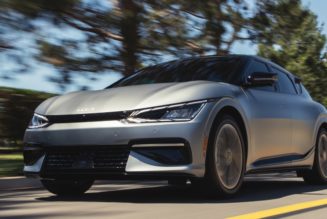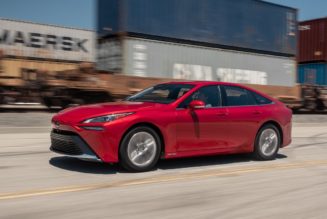We established in the introductory story that I don’t seem to drive a lot of Civics despite my job being to drive all the things, so the short-long-term 2020 Honda Civic Si and I are still getting acquainted. So far, so good.
Some of my colleagues have been down on this generation of Civic Si because it has a 1.5-liter turbocharged four-cylinder engine tuned up from everyday Civi spec, not a purpose-built, naturally aspirated, high-rpm screamer like past generations of Si. As much as I love a good naturally aspirated engine, this doesn’t bother me, mostly because I never formed an emotional attachment to those old Si models. Maybe it was lack of sufficient exposure, but I’m not mad about this engine.
Not that folks’ criticisms are nonsense. The engine is laggy, like they say, and the revs hang when you upshift. Neither of those things really bugs me, though. Driving normally, out running errands or whatever, there’s enough torque to scoot around in traffic just fine. You don’t need to rev it out, and it doesn’t feel slow. It feels like a Civic. The light switch action of the turbo happens around 3,000 rpm, and when I’m just puttering around town, I shift at 3,000, so I never notice it. If I want the power of the turbo for a bit of fun driving, it’s only a downshift away. The six-speed manual’s tightly spaced ratios make it easy as pie to keep the engine in whatever rev range you want, so you can keep the turbo on the boil at all times or leave it switched off. Just drive how you want it to respond.
The rev hang hasn’t been an issue in everyday driving, either. It’s hardly the worst rev hang I’ve experienced in a modern manual transmission car, for starters, because it’s a direct-injected engine. The Engineering Explained channel on YouTube has a great explainer video, but the short version is this: Modern cars have electronic throttle systems that are programmed to close the throttle valve more slowly than a mechanical system would in order to improve emissions. Automatic transmissions can easily mask this, but for manuals, it results in rev hang, where the engine speed (rpm) doesn’t drop as quickly as it would with a mechanical system. As a result, when you upshift a modern manual, you can easily release the clutch before the rpms have dropped enough due to the hang, causing the car to jerk as the transmission and engine speeds equalize via the slipping clutch.
Thing is, it’s easy enough to drive around. Knowing the engine is going to take longer than experience with mechanical throttles would suggest, I just shift slower. I change gear slower, and I release the clutch slower, both of which give the engine time to hang and then lose speed. It just takes a little slowing down to completely avoid the jerk, and when I’m just driving around town, I don’t need to be speed-shifting anyway. The real test, though, will be how easy it is to drive around when I get the Si out on my favorite mountain road, which I’ll do in the next update.
Regardless of what the throttle’s doing, the transmission itself is a gem. Sure, like all manuals, it’s a little stiff in the morning when the gear oil is cold, but it just presents as a little notchy. Once it’s warmed up, though, it’s perfect. Only two companies on the planet build manual transmissions this good: Honda and Porsche. The shifter isn’t just buttery smooth with delightfully short throws right from the factory; it slips into the next gear (up or down) perfectly every time, as if there’s some device in there helping position all the forks and gears and such for you so you never miss a shift. You just gently nudge it in the general direction of the gear you want, and it goes neatly into place. You never hunt for a gear, never get caught out between gears. Transmissions like this are why people like driving stick.
As with the powertrain, the chassis, too, can change its stripes at the push of a button labeled “Sport.” With standard two-mode adaptive dampers, the Si’s ride becomes noticeably firmer in Sport mode. Considering it starts out firm for a compact sedan, this mode ain’t messing around. It’s stiff, and it’s meant for performance driving. Naturally, it sharpens up the throttle response and plays with the steering assistance, as well. In many cases, I like to be able to adjust these parameters separately, say, to get better throttle response with comfort damping for driving around town. The Si is set up so nicely out of the box, though, that I don’t feel the need to trade ride comfort for throttle response and hit the Sport button every time I start the car.
I do need to wait a tick when I turn off the car, though. Likely for emissions reasons yet again, the Si needs a full 2 seconds after you hit the engine start/stop button and the dash goes dark and radio shuts off before the engine stops spinning. I like to shut my manual transmissions off in-gear with the clutch in so I won’t forget to do it after I turn the car off. In most manual transmission cars, the engine goes off when everything else does, and you can release the clutch immediately. Not the Si. If you don’t wait until you feel the engine stop vibrating and pop the clutch too soon, you’ll make the whole car jump. Not great for your clutch—or anything you may be parked close to.
Stiff ride or no, the sporty seats fitted to the Si are an excellent compromise between support and comfort. They have big bolsters that feel like they’ll do a good job when needed, but the padding is plenty soft, so they don’t get uncomfortable on longer drives.
What does get uncomfortable, though, is that aluminum-topped shift knob. Aluminum shift knobs look cool and feel good in your hand, but the metal is a hell of a heat conductor, and that’s bad news for your right hand. On a warm day, that little disc is approximately 8 million degrees, and on a seriously cold day, it’s minus 4 million degrees. Either way, it’s extremely uncomfortable to handle more than half the year. Thankfully, I learned this lesson a long time ago when I installed an aluminum shift knob on my own car, so I know to keep a rag in the car to throw over the shifter when I park it. Doesn’t guarantee the knob won’t be super hot or super cold, but it’ll protect your hand.
Now that we’ve gotten to know each other, it’s time to drive this car like it was meant to be driven. Performance impressions are on deck for the next update.










